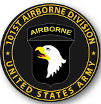

A 42-day search-and-destroy operation in KONTUM Province by elements of the 1st Brigade, 101st Airborne Division.
(USMACV; Command History 1967; Volume III; 16 September 1968)
Headquarters I Field Force Vietnam directed the 1st Brigade, 101st Airborne Division to move by air from TUY HOA to KONTUM and conduct search and destroy operations adjacent to the CAMBODIAN border in the PICKETT area of operation. During the Christmas truce the mission was slightly altered and the Brigade was subsequently deployed in an expanded PICKETT area of operation to the north and east of KONTUM city. Concurrent with the tactical operations the Brigade was to conduct airborne refresher training.
The initial concept of PICKETT called for a rapid air move from the TUY HOA to KONTUM. Upon closing KONTUM the Brigade was to deploy into the assigned area with two battalions and supporting forces; maintaining the third battalion as the Brigade Immediate Action Force. After the Christmas truce the Brigade clandestinely entered the expanded PICKETT area of operation with two battalions conducting night airmobile infiltrations. The two maneuver battalions with supporting forces conducted search and destroy operation utilizing semi-guerrilla tactics. The third maneuver battalion conducted airborne training and assumed the mission of Brigade Immediate Action Force. An airborne training program was established and all Brigade units were rotated through the cycle.
Operation PICKETT was conducted in three phases: the air move from TUY HOA to KONTUM; the search and destroy operation adjacent to the CAMBODIAN border; and the offensive operations in the DAK AKOI Valley north and east of KONTUM city. Airborne refresher training was conducted concurrently with Phase III of the tactical operation. Contact was relatively light throughout the operation with the preponderance of contacts being made with relatively small enemy units. ARVN and para-military forces in the area greatly supplemented the maneuver units of the Brigade permitting greater coverage of the area of operation. The Brigade made extensive use of aviation assets to include a two battalion night airmobile infiltration and displacements of the supporting 155mm Artillery battery, B/1-30 ARTY, by CH-54 flying crane. The Brigade continued to refine and employ semi-guerrilla tactics which are characterized by the use of stealth, deception, and surprise until contact with the enemy is made. Once contact is made, the guise of the guerrilla is lifted and all available firepower and reaction force are utilized conventionally to capture or destroy the enemy force. The terrain in the area of operation included dense jungle, rugged mountains, rolling hills, swift mountain streams and rivers. High winds and air turbulence delayed several airmobile operations. During the operation 109 individuals and crew served weapons, 226 grenades, 140.6 pounds of TNT, 50.9 tones of rice, ammunition and other equipment were captured.
(HQ, 1BDE, 101st ABN DIV; Combat Operations After Action Report, Operation PICKETT; 15 February 1967)
Unit(s) tasked organized or under brigade control: 2-502 IN BN
Operation Pickett commenced on 06 December 1966 and terminated on 19 January 1967 with the following results:
Friendly: 23 KIA, 104 WIA
Enemy: 63 KIA, 18 PW, 14 DET, 108 I/W, 1 C/S
 |
 |
 |